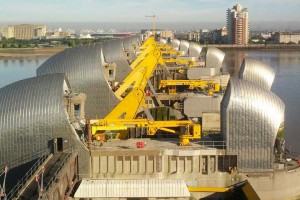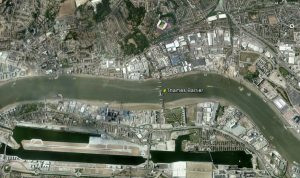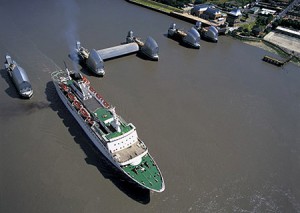Falling Down the Thames Blog 49, 18th February 2015
The Thames Barrier in 2015
In last week’s blog, I briefly described the Thames Barrier, a project designed to help protect the city of London from flooding. That engineering marvel has now been in operation for a third of a century. What actually is it? How is it doing? Is the great city of London still at risk from the River Thames? Let me fill you in…
I am not an engineer, but I know a good piece of kit when I see it. The Thames Barrier is it. Construction began in 1974, and was completed eight year later. The barrier spans the Thames near Woolwich where the river is a little over 500 metres wide. The barrier involves a system of ten steel, semi-circular gates which can be rotated into place when deemed necessary. Each gates weights 3,300 tonnes, which was, by strange coincidence, the weight of blueberries exported from Peru in 2014. When the barrier is put into operation, 125 square kilometres of London is protected against flooding. This is an area two-and-a-half the size of Bermuda. I gather that the eastern boroughs of London are not protected by the barrier. Perhaps no one special lives in east London.
When a combination of data indicate a possible flood threat, the first step is to halt traffic up and down the river. The gates are raised until the threat has passed, and then normal circumstances are restored.
A variety of circumstances can cause a flood threat. First, a particularly high tide can combine with the wrong sort of storm to drive seawater up the Thames Estuary. Then it is time to raise the barrier. Alternatively a very high tide could meet a particularly large volume of water coming downstream. The trick then is to close the barrier at low tide in anticipation of problems, creating a void to be filled by river water, which can be released later on the falling tide.
The barrier is put into operation at least once a month for testing and routine maintenance. When the barrier was first created, it was expected to be needed to prevent flooding two or three times each year. It was used once each in 1983, 1985, 1987 and 1988, and called upon not at all in 1984, 1986 or 1989. Since then the barrier has been required more and more frequently. The Environment Agency closed the barrier nineteen times in 2003, and an astonishing forty-eight times in 2014. The River Thames acted rather badly in 2014.
And what about the future? According to the best guesses of experts, the Thames Barrier should protect London from flooding until the year 2070. After that…? We have fifty-five years to come up with a new crop of creative engineers to deal with the additional issue of rising sea levels.
Krista and I are scheduled to paddle through the Thames Barrier on the morning of Friday 1 May. Keep us in your thoughts.
- Glen
Photo credits: The Thames Barrier – www.gov.uk; satellite view – Google Earth, posted in wreforum.org; ship passing through the Thames Barrier – www.bbc.co.uk



